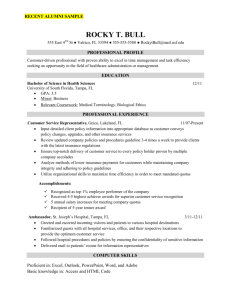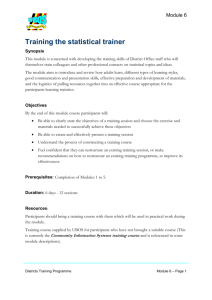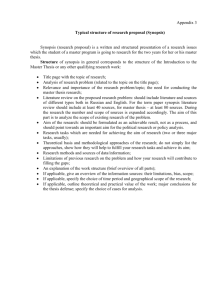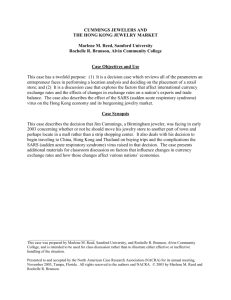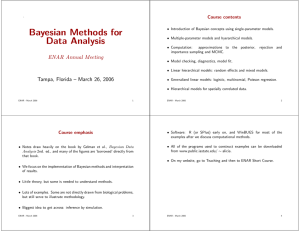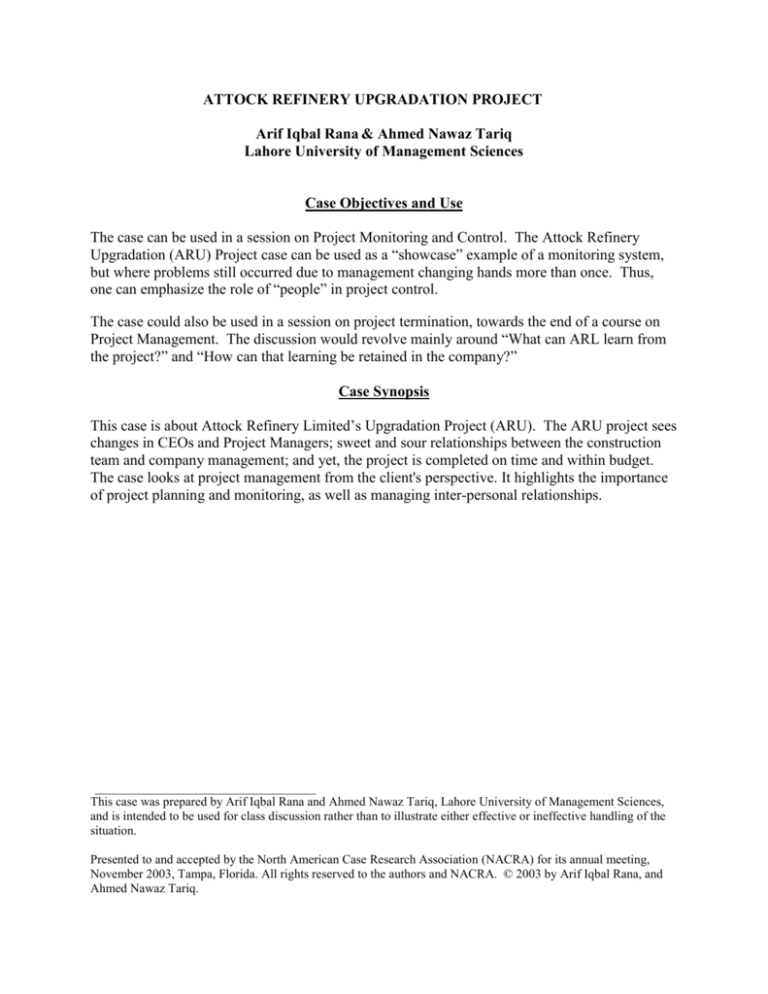
ATTOCK REFINERY UPGRADATION PROJECT
Arif Iqbal Rana & Ahmed Nawaz Tariq
Lahore University of Management Sciences
Case Objectives and Use
The case can be used in a session on Project Monitoring and Control. The Attock Refinery
Upgradation (ARU) Project case can be used as a “showcase” example of a monitoring system,
but where problems still occurred due to management changing hands more than once. Thus,
one can emphasize the role of “people” in project control.
The case could also be used in a session on project termination, towards the end of a course on
Project Management. The discussion would revolve mainly around “What can ARL learn from
the project?” and “How can that learning be retained in the company?”
Case Synopsis
This case is about Attock Refinery Limited’s Upgradation Project (ARU). The ARU project sees
changes in CEOs and Project Managers; sweet and sour relationships between the construction
team and company management; and yet, the project is completed on time and within budget.
The case looks at project management from the client's perspective. It highlights the importance
of project planning and monitoring, as well as managing inter-personal relationships.
___________________________________
This case was prepared by Arif Iqbal Rana and Ahmed Nawaz Tariq, Lahore University of Management Sciences,
and is intended to be used for class discussion rather than to illustrate either effective or ineffective handling of the
situation.
Presented to and accepted by the North American Case Research Association (NACRA) for its annual meeting,
November 2003, Tampa, Florida. All rights reserved to the authors and NACRA. © 2003 by Arif Iqbal Rana, and
Ahmed Nawaz Tariq.
SCHEDULING AT A HOSPITAL CALL CENTER
Gary Clendenen, University of Texas, Tyler
Dee Ann Dorsey, East Texas Medical Center
Case Objectives and Use
Case objectives include the following: analysis of hourly and daily call volume to look for
patterns during the week; apply either queuing theory and/or basic concepts from probability to
determine the minimum number of employees needed during each hour to provide acceptable
service levels; compare and contrast results from queuing theory and from basic probability
concepts; and, formulate and solve an integer-programming model and interpret the output.
This case is appropriate for students in undergraduate classes in either Management Science or
Operations Management. This case could be used in either class in association with material on
waiting lines covering the basic multiple-channel queuing model. Alternatively, if there is a
desire to use the case apart from waiting lines, simple probability concepts could be used to
approximate the minimum number of servers at any given time. Either way, students could then
use an integer programming formulation to explore minimal cost options for the scheduling of
employees.
Case Synopsis
East Texas Medical Center Regional Healthcare System (ETMC) is a regional 454-bed hospital
in East Texas. ETMC uses a call center to schedule appointments for patients on an outpatient
basis for hospital services such as MRI scans, CT scans, blood tests, etc. Physician office
employees and sometimes physicians themselves phone the call center and requested specific
tests by hospital departments for individual patients on an outpatient basis. Call center
employees made outbound calls to various hospital departments to make the appropriate
appointments. There was intense competition for outpatient services in the area and callers
typically would not wait on a phone for a scheduler for more than 30 to 40 seconds before
hanging up. Management viewed a lost call as lost business since callers could simply call a
competitor after hanging up. Thus, the wait time in queue needed to be less than 30 seconds.
Call center manager, Dee Dorsey, manages the call center and is being pressed to cut costs, if
possible, and to increase service. She has collected three months data on hourly inbound call
volumes and is trying to determine the best schedule for her employees using both cost and
service as criteria.
___________________________________
This case was prepared by Gary Clendenen, University of Texas, Tyler and Dee Ann Dorsey, East Texas Medical
Center, and is intended to be used for class discussion rather than to illustrate either effective or ineffective handling
of the situation.
Presented to and accepted by the North American Case Research Association (NACRA) for its annual meeting,
November 2003, Tampa, Florida. All rights reserved to the authors and NACRA. © 2003 by Gary Clendenen and
Dee Ann Dorsey.
INVENTORY MANAGEMENT AND CUSTOMER SERVICE LEVELS
AT SAINT-GOBAIN CONTAINERS
Enar Tunc, Ball State University
Case Objectives and Use
The purpose of this case is twofold:
1.
The nature of the first purpose is tactical decision making in inventory management. The
problem in the case can be used to teach the computation of safety stock levels.
2.
The second purpose is to show students the impact of forecast errors on the safety stock
levels, and to identify strategies to reduce forecast errors through collaboration with
customers.
As the computation of the safety stocks require advanced knowledge of inventory management,
the case can be used in an advanced operations management course at the undergraduate level or
an MBA course dealing in operations management or supply chain management.
Case Synopsis
Saint Gobain Containers has been using an arbitrary number to determine its safety stocks. The
symptoms of the problem are the excess inventory kept in safety stock while they run out of
stock on some of the items. This means that capacity at the plants is used to produce some items
in excess while the planners scramble to schedule other items. At the moment, there is a need to
analyze the forecast data compared to the actual sales to understand the source of the problem.
___________________________________
This case was prepared by Enar Tunc, Ball State University, and is intended to be used for class discussion rather
than to illustrate either effective or ineffective handling of the situation.
Presented to and accepted by the North American Case Research Association (NACRA) for its annual meeting,
November 2003, Tampa, Florida. All rights reserved to the author and NACRA. © 2003 by Enar Tunc.
OILFIELD METALS LP:
A CASE OF ALLIANCES IN STRATEGIC SUPPLY CHAIN MANAGEMENT
Joe Kavanaugh & Henry S. Maddux III, Sam Houston State University
Dave Warren, Energy Alloys
Case Objectives and Use
The objectives of the case are as follows: a) to provide the basis for students to understand many
of the foundation principles of supply chain management in terms of physical and informational
flows; b) to develop an appreciation for the role of developing sole supplier relationships in
providing competitive advantage for players within supplier chains; c) to enable students to
identify and describe the supply chain models that are appropriate under varying competitive
environments and how each of these chains adds value to customer operations; d) to highlight the
roles that organizational flexibility, agility, and creativity play in enabling small companies to
compete with larger competitors; and e) to identify the environmental forces that drive the
adoption of the various supply chain models and to understand the unique disadvantages and
advantages of each model?
This case can be used in several different academic venues: Supply Chain Management,
Operation Management and Strategic Management.
Case Synopsis
This case deals with the opportunities and decisions faced by the managers of Oilfield Metals LP
(OMLP), a distributor of specialty metal products that serves the oilfield industry. The 7-yearold company’s rapid growth has resulted from a keen focus on developing close working
relationships with large strategic accounts or alliance partners. OMLP has a successful history of
winning and retaining these accounts by leveraging their extensive technical experience and
unique design of supply chains within the industry. These alliances have resulted in long-term
commitments from several key customers or players within the supply chains to designate
OMLP as the preferred provider of tubular steel products. The primary motivator of these
commitments has been the ability of the managers to demonstrate the effectiveness of creatively
engineering supply agreements to provide value to customers in terms of on-time delivery,
technical problem solving, and reduction in the overall cost of purchasing. Now the principals
are attempting to consolidate and leverage the learning that has resulted from developing these
existing capabilities into principals for conduct and supply chain management in the future.
___________________________________
This case was prepared by Joe Kavanaugh and Henry S. Maddux III, Sam Houston State University, and Dave
Warren, Energy Alloys, and is intended to be used for class discussion rather than to illustrate either effective or
ineffective handling of the situation.
Presented to and accepted by the North American Case Research Association (NACRA) for its annual meeting,
November 2003, Tampa, Florida. All rights reserved to the authors and NACRA. © 2003 by Joe Kavanaugh,
Henry S. Maddux III, and Dave Warren.
POLYONE: INTEGRATING SUPPLY CHAIN MANAGEMENT SYSTEMS
Julie Brandt, Kim Khanh Hoang, Scott Lamb, Matt Sink &
Robert McGlashan (faculty supervisor)
University of Houston-Clear Lake
Case Objectives and Use
The case allows students to analyze the business philosophies of two different companies that
operate in the same industry and how these philosophies affect the supply chain management
(SCM) systems of the two companies. The case allows students to compare and contrast the
SCM philosophies of the two companies and how they originated. The case further provides the
opportunity to discuss the challenges involved in integrating two quite different SCM systems
after the two companies merge.
This case is suitable for use in undergraduate or graduate operations management courses or in
strategic management courses where the discussion focuses on supply chain management issues.
Case Synopsis
The case describes two different businesses, M.A. Hanna and The Geon Company, within the same plastics
compounding industry in terms of history, marketing strategy, structure, management, capabilities, and supply chain
management strategies preceding their merger into PolyOne. The first issue in the case is analytical. Since strategic
management involves managing the enterprise to achieve superior performance, sources of profit available to both
businesses are identified and evidence is offered as to how each company separately formulated and implemented
supply chain strategies that exploited sources of profit. The case reflects the impact of key forces reshaping today’s
supply chain management environment.
The second issue involves how both firms are managed under conditions of rapid change that require new
approaches to strategy analysis. We explore the patterns of industry evolution and the sources of strategic
innovation within PolyOne. The case gives particular prominence to the impact of the rapid development
of e-commerce.
Finally, the case presents information about both Hanna and Geon highlighting the effects and
suitability of the imposed strategic management changes. While some firms within an industry
are subject to intense price competition and need to adapt through e-commerce and information
flows, other firms may also increase competitive pressure through continuing to be “bricks and
mortar” businesses.
___________________________________
This case was prepared by Julie Brandt, Kim Khanh Hoang, Scott Lamb, and Matt Sink, and Robert McGlashan
(faculty supervisor), University of Houston-Clear Lake, and is intended to be used for class discussion rather than to
illustrate either effective or ineffective handling of the situation.
Presented to and accepted by the North American Case Research Association (NACRA) for its annual meeting
November 2003, Tampa, Florida. All rights reserved to the authors and NACRA. © 2003 by Julie Brandt, Kim
Khanh Hoang, Scott Lamb, and Matt Sink.
WORK CENTER OPERATIONS AT ERDEM KIMYA, INC.
Birsen Karpak & C. Louise Sellaro
Youngstown State University
Case Objectives and Use
The objectives are to provide the student with insights about the problems of “tacit knowledge,”
especially in the case of the retirement of the employee who has it. Students are urged to evaluate
the existing documentation and search for an alternative documentation system if possible. For
students, this case also reflects concerns related to succession planning and asks them to generate
alternatives for the company.
This case can be used in Production/Operations Management and Small Business/
Entrepreneurship courses at the undergraduate level.
Case Synopsis
Erdem and Nursel Targul are the owners of a detergent manufacturing company, Erdem Kimya,
Inc. (EKI). During the 1990’s the industry moved into a growth stage and issues of competition
began to emerge with other small firms that produced similar products. To differentiate
themselves in the market, they acquired “Responsible Care” certification which has only been
awarded to a very few Turkish companies.
One of the foremen was about to retire, and Nursel wondered about the best way to proceed.
With his imminent departure, the Targuls realized a weakness in EKI operations existed; there
was a lack of written documentation on work center operations. When the documentation was
prepared, management was not sure whether it was sufficient, and if an alternative, better
description of the processes should be developed.
___________________________________
This case was prepared by Birsen Karpak and C. Louise Sellaro, Youngstown State University, and is intended to be
used for class discussion rather than to illustrate either effective or ineffective handling of the situation.
Presented to and accepted by the North American Case Research Association (NACRA) for its annual meeting,
November 2003, Tampa, Florida. All rights reserved to the authors and NACRA. © 2003 by Birsen Karpak and C.
Louise Sellaro.



